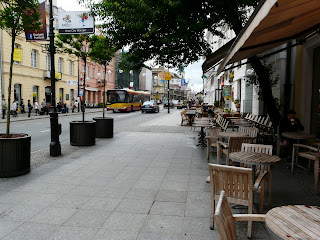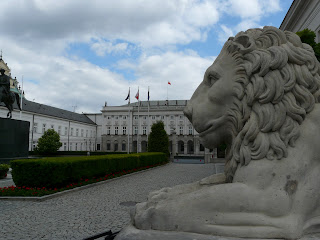After visiting Warsaw, we went to Krakow. Krakow was the capital of Poland from its early years until 1596 when it was moved to Warsaw. It was home to the early kings and the church leaders. Unlike Warsaw, Krakow was not destroyed during WWII--most of its buildings survived and are centuries old.
Wawel Castle--the former residence of Polish royalty
Up the hill in the rain to Wawel Castle
Every little girl needs an ice cream cone at the Main Market Square (Rynek Glowny). The Cloth Hall (building in the background) is in the middle of the square. It was built after the original Cloth Hall burned down in 1555.
St. Mary's Church on the Main Market Square
Putting a few coins in the street performer's bucket
She was brave enough to shake hands (with the help of her mom)
The ultimate in multi-tasking--Sight seeing and drinking beer at the same time
Main Market Square--the town revolves around this square. When it was established in the 13th century, it was the biggest square in medieval Europe. It is very large and completely surrounds the Cloth Hall.
Statue of Adam Mickiewicz in the middle of the Square. Mickiewicz is considered to be the Polish Shakespeare. His masterpiece is Pan Tadeusz.
The opposite side of the Great Market Square
The little one loved to chase the pigeons
About two minutes after this picture was taken, the little one decided that she was thirsty and bent down in this gutter and started drinking the rain water before I could stop her--not the best drink!!
Plenty of carriages to ride in
All smiles at the Italian restaurant
This picture gives the phrase, "picking your friend's nose" a new meaning. It would be a BIG job.
The original city wall fell into disrepair in the 19th century. Krakow decided to tear down the wall and fill the moat--and then plant trees. Called the Planty, it is now a beautiful park running 2.5 miles encircling the entire perimeter of Krakow's Old Town.
Beautiful old building
Royal Way--the street from the Florian Gate down to the Main Square and then onto Wawel Castle.
Florian Gate and remaining city wall
The remaining piece of the city wall
The Barbican and the Florian Gate
We rode in a covered cart and took a city tour on a rainy day
Born in a small town near Krakow, Karol Wojtyla is considered by many to be the greatest Pole. He is better known as Pope John Paul II. This was his residence before moving to Rome. On his return to Krakow, he spoke to the people from this window.
Old Town
Street in Old Town
Mary Magdalene Square
Teaching the little one about jewelry
The Barbican
Beautiful interior of a Catholic Church
The Jewish Quarter--Before WWII, Krakow was home to 65,000 Jews (one fourth of Krakow's population). Today, there are only about 200 Jews that live in Krakow.
Jewish Synagogue
Another Jewish Synagogue
Jewish businesses
Monument to Jews killed in the war
Jewish business










































































































